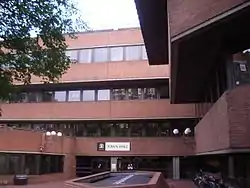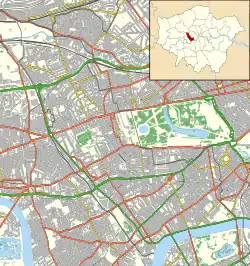Kensington Town Hall, London
Kensington Town Hall is a municipal building in Hornton Street, Kensington, London. It is the headquarters of Kensington and Chelsea London Borough Council.
| Kensington Town Hall | |
|---|---|
 Kensington and Chelsea Town Hall | |
 Kensington Town Hall Location within Royal Borough of Kensington and Chelsea | |
| General information | |
| Architectural style | Brutalist style |
| Location | Kensington, London |
| Coordinates | 51.50202°N 0.19515°W |
| Completed | 1976 |
| Inaugurated | 1977 |
| Design and construction | |
| Architect | Sir Basil Spence |
| Main contractor | Taylor Woodrow Construction |
History
The building was commissioned to replace the old town halls of Kensington and Chelsea following the amalgamation of the two boroughs to form the Royal Borough of Kensington and Chelsea in 1965.[1] After both the old town halls had been rejected as inadequate for the council's needs, civic leaders decided to procure a new facility; the site selected for new building in Hornton Street had previously been occupied by two large residential properties: Niddry Lodge and the Red House.[2][3][lower-alpha 1]
The construction work, which was undertaken by Taylor Woodrow Construction at a cost of £11.6 million,[5][6][7] started in 1972.[2] The architect, Sir Basil Spence, had been commissioned to design the building in the Brutalist style but he died ten days before the building was completed on 29 November 1976.[8] The building was officially opened by Princess Anne on 31 May 1977.[9]
The design for the new facility, which made extensive use of red brick, involved a large square building to the north, which would accommodate council officers and their departments on an open plan basis as well as a civic suite at the southern end, and two octagonal buildings to the south, the western building being a public hall and the eastern building (raised up on concrete columns) being the council chamber.[8] The main square building contained an inner courtyard which preserved several trees including a giant redwood tree planted by Baroness Churchill in memory of her husband, Sir Winston Churchill, in 1967.[10] The design for the main frontage on Hornton Street featured glass doors on the left of that elevation, which gave access to the civic suite, on the ground floor; there were tall oriel windows on the first floor which was cantilevered over the pavement.[8]
An ornamental pool which had been created beneath the council chamber was converted into a small garden planted in memory of Princess Alice, Countess of Athlone and was opened by the Duke of Gloucester on 4 May 1983.[10]
Works of art in the mayor's parlour include a portrait of the collector, Sir Hans Sloane, by Thomas Murray.[11]
Notes
- Niddry Lodge, built in 1831, had been the home of General Sir John Fraser until 1843, the home of the Dowager Countess of Hopetoun until 1854 and then the home of John Francis Campbell until 1885.[4] Meanwhile, the Red House, built in 1835, had been the home of President Herbert Hoover from 1914 to 1917.[4]
References
- "Watercolour of Kensington and Chelsea Town Hall by the architect Sir Basil Spence". Rbkc.gov.uk. 20 April 2005. Retrieved 18 June 2017.
- "Building site 1972-1975: Kensington Town Hall". RBKC Kensington Central Library. Retrieved 5 May 2020.
- "Ordnance Survey Map". 1968. Retrieved 5 May 2020.
- Sheppard, F H W (1973). "'The Phillimore estate', in Survey of London: Volume 37, Northern Kensington". London: British History Online. pp. 58–76. Retrieved 8 September 2020.
- Walker, David (2008). "Civic Centres". University of Warwick. Retrieved 9 September 2020.
- Altman, John (2016). In the Nick of Time - The Autobiography of John Altman, EastEnders' Nick Cotton. John Blake Publishing. ISBN 978-1786062567.
- "London's Town Halls". Historic England. p. 133. Retrieved 5 May 2020.
- Walker, David. "Kensington and Chelsea Town Hall". c20society. Retrieved 26 July 2015.
- "The Royal Borough of Kensington and Chelsea". Royal Borough of Kensington and Chelsea. Retrieved 5 May 2020.
- "Royal Borough of Kensington and Chelsea Town Hall, London". Manchester History. Retrieved 9 September 2020.
- Murray, Thomas. "Sir Hans Sloane (1660–1753)". Art UK. Retrieved 9 September 2020.